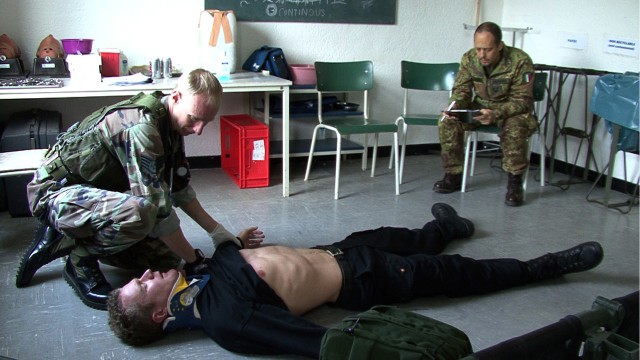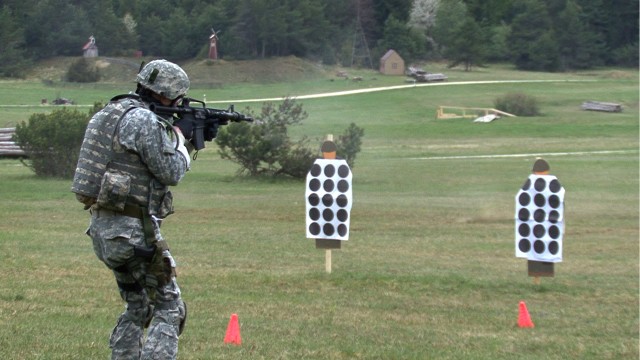GRAFENWOEHR, Germany -- On a wet spring day in southern Germany, Sgt. Derek Varchulik is working on his marksmanship. There's nothing particularly special about that, since thousands of U.S. Army, Europe Soldiers are constantly improving their weapons skills on ranges operated by the 7th Army Joint Multinational Training Command (JMTC). After all, the JMTC is the U.S. military's largest overseas training command.
But a quick glance up and down Varchulik's firing line reveals a difference. Sgt. Varchulik is the only American Soldier on this firing line. He's one of about two dozen soldiers from NATO partner nations taking part in a close-quarter battle course (CQB) taught by the International Special Training Centre (ISTC) in Pfullendorf, Germany.
The ISTC training was once exclusively reserved for NATO special operations forces. But the nature of recent conflicts has increased the demand for the advanced combat, survival and medical skills the center teaches. This is particularly the case among conventional U.S. forces, which may experience situations in Iraq and Afghanistan that require unconventional training.
To meet those needs, ISTC is now offering its courses to select conventional Soldiers, sailors, airmen and Marines.
That has opened the door to soldiers like Varchulik, who is hoping to incorporate the special operations techniques into his own training program as an individual pre-deployment instructor with the JMTC.
"Sometimes Soldiers (that I train) have questions how to do things differently," said Varchulik. "With this training I'll be able to say 'You can do it this way, also. Here's the preferred method, but under certain circumstances, you might have to do things a different way.' And this training is a great tool for that."
A few miles away, Air Force Staff Sgt. Aaron Applewick is struggling to master the lifesaving techniques of the ISTC's combat medic course. His classmates wince as Applewick makes a second attempt to insert an I.V. into his patient's arm. The beads of sweat on Applewick's forehead and the small puddle of blood under his patient's arm can attest to the fact that it's not going well. But this is only the end of the first week of medical training, and the instructor seems pleased with Applewick's efforts.
Like Varchulik, Applewick is attending the ISTC course to better prepare him for his job of teaching airmen the emergency medical skills they need before they deploy into a war zone.
The challenges of the ISTC's combat medic course for conventional servicemembers like Applewick are compounded by the fact that English is a second language for the instructor and many of the students.
However, Applewick thinks the language and cultural differences will actually help him to become a better combat medic.
"If you're ever downrange and you have to care for somebody of another nationality," said Applewick. "You know kinda how they're going to act, and how they are, and you're not nervous around them."
"When you truly have a multinational cadre that is teaching multinational students," said ISTC Command Sgt. Maj. Richard "Spike" Klein, "the interactions the conventional soldiers get and their experiences are a valuable tool for preparing them for going downrange."
The challenges of learning in a diverse environment keep most soldiers -- whether they are special or conventional forces -- on a level footing, said Klein.
U.S. Army, Europe soldiers interested in attending ISTC courses should log on to the Army Training Requirements and Resources System (ATRRS) to apply for the course.
For more information about the International Special Training Centre, log on to the 7th U.S. Army JMTC homepage at www.hqjmtc.army.mil.






Social Sharing